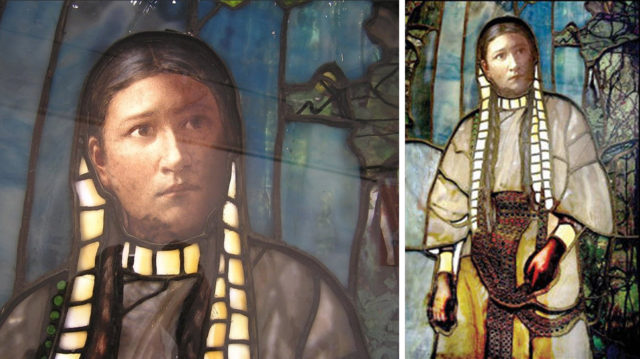To say that Anne Weston had an interesting life would be an understatement. She was born during a flu epidemic in New York City and, unfortunately, her Mother did not survive the epidemic and she was put up for adoption by her Father, who wanted the best for his beautiful daughter but was unable to work full-time and properly care for her. Enter Frank and Mabel Vanderlip. Frank was a very wealthy and influential banker in New York City and served as the Assistant Secretary of the Treasury of the United States of America. The Vanderlips were friends with the Rockefellers, Carnegies, Vanderbilts and Fricks. Frank was also one of the Founding Trustees of the Metropolitan Museum of Art. It is likely that through his philanthropic work at the Met that he became friends with Louis Comfort Tiffany, the renowned jeweler and artisan. Next time you visit the Minneapolis Institute of Arts notice how many of the donor plates mention the Vanderlip name. It is assumed that because his daughter was in Duluth and he and Mabel would often visit her here that he chose to endow the MIA with several pieces from his collection and with a financial endowment to assure their safe keeping.
In 1892 Tiffany was feverishly working to create stained glass windows for many of the buildings in the “White City” as the Columbian Exposition was often referred to when the Allied Glass Workers Union went on strike. With very little time to complete the windows for the Columbian Exposition, Tiffany sought counsel and advice from Vanderlip who suggested that he hire talented and bright women to do the work…his daughter, Anne among them. Tiffany did hire about twenty five women to execute the windows he was contracted for at the exposition and found Anne to be a born leader and possessing an excellent eye for color, composition and style. Once the strike was settled, Tiffany insisted that his “Tiffany Girls” be allowed to continue in the art department.
Anne not only designed but helped execute Duluth’s most famous stained glass window, the Minnehaha window now on display at the St. Louis County Heritage and Arts Center, the Depot. Very quickly Anne became the leader of the art group at Tiffany & Company and even started to create designs for windows in the Tiffany style. It is interesting that very few records, beyond payroll and personnel, mention Anne, but then, Louis Comfort Tiffany was a good businessman and he wanted all of his clients to assume that he was intimately involved in the creation of every piece of work generated through his office…whether jewelry or stained glass windows or efflorescent glasswork lampshades, vases or vessels.
At a reception at the Metropolitan Museum of Art Anne met a dashing, young, doctor who was working at one of the large hospitals in New York City but who was far more interested in being close to nature and moving near the Great Lakes…in particular, with the amount of money being generated and the growth opportunities presenting themselves in Duluth, Minnesota, he was desirous of moving to Duluth. No doubt his friendship with J. P. Morgan had an influence on his decision to move north.
Over the next several months, the relationship and love between John and Anne grew and they were married at the Metropolitan Museum of Art in 1895. Shortly after they were married, John and Anne moved to Duluth, and Anne set up a studio space in their new home on Twenty-Second Avenue East and Superior Street and John established a medical practice in Lakeside. Anne continued to design windows for Tiffany, completing at least thirteen known commissions in Duluth spread among Pilgrim Congregational Church, First Presbyterian Church, the Duluth Board of Trade Building, Duluth City Hall and a smattering of private residences. Interestingly enough, none of the windows at Glensheen are attributed to Tiffany.
Louis Comfort Tiffany traveled from New York to Duluth on at least two occasions and was a welcomed guest at both the Weston and Silberstein homes. Bernard Silberstein with a business Partner, Isador Bondy, had established an exclusive dry goods store on Superior Street and had a large selection of Tiffany Jewelry and decorative objects for sale to their carriage trade.
Anne continued to design pieces for Tiffany until World War 1, after which the demand for such work waned and Anne focused her attention on raising her family and smaller artistic works on her own.
In 1980 I was building a home in Duluth and wanted to include some stained glass work. Working with St. Germain’s, I was introduced to Rosemary Weston, a great-granddaughter of Anne Weston. Rosemary told me a little of her Great Grandmother and her influence on her work. Rosemary taught classes through the Duluth Public Schools continuing education programs before moving to Bayfield, Wisconsin and eventually Madeline Island where she resides to this day.

